
Chocolate. March. North African city. Potential colonization in our lives. Mars, we lend more to human existence. It's a fascinating asteroid that has caught our attention ever since Galileo first spotted it on a starry night with his telescope in the 17th century. And now, more than ever, maybe even this life can be our next home! Notice 44 otherworldly realities that could lead to a mini-existential crisis on Mars.
Sudden Weight Loss
If humans could set foot on Mars, we would feel lighter. This planet is smaller than Earth and the surface has less gravity, actually 62.5% less gravity. So, if you weigh 90 kilos (200 lbs), you're just a light and bouncy 34 kilos (76 lbs) on Mars! Who needs a diet that we can finally move to Mars one day?

Outer Space Volcano
Yes, there are volcanoes on Mars, and one of them is serious business. A shield volcano called Olympus Mons, almost 22 km high, rising three times over Mount Everest with a diameter of 600 km. It covers roughly the same amount of area as mainland France!
Lost, But Not Forgotten
Any deceased scientist or researcher who has contributed to the study of Mars will forever live up to their name in red planet-craters larger than 60km (37 miles). contribute.
wires It can be confusing
Any crater less than 60 km in diameter is named after an Earth with a population of less than 100,000, such as Surrey.
Mars by Numbers
The diameter of Mars is 53% of the diameter of the earth, making it the second smallest planet in the solar system after Mercury.
Where do you start?
NASA plans to create an "Independent" Mars colony over the next few decades. In the 2030s, “We seek the capacity for people to work, learn, operate and live sustainably beyond Earth for an extended period of time”. blown
Brave Souls
More than 100,000 people are ready to leave Earth in search of the red meadows, where they resort to making a one-way trip to Mars as part of Mars.
Capital Mars
The name of Cairo, the capital of Egypt, comes from the Arabic name for Mars, “al Qahir”. The city was named after the planet, because Mars was elevated from the day the city was founded.
It Doesn't Mean Time
One year on Mars, 68 years on Earth, exactly 687 days. However, the Martian has been on our home lawn for more than just 24 hours a day.
Small Steps
Soil collected from Mars still does not give us a concrete conclusion to the question of whether there is life on the planet. However, it is excellent for growing asparagus and turnips, but not good for strawberries or blueberries, thanks to it being more alkaline than acidic. Guess I'll have to ditch the blueberry pancake addiction, asparagus pancakes don't do well.
Is Climate Change Good?
Mars is cold, so in order to make it more hospitable for future colonization, scientists want to warm up a bit, initiating global warming with "warming". This includes increasing carbon dioxide and water vapor in the atmosphere. To create warmer temperatures in the atmosphere
There Is Winter
Radar images from NASA showed that there was indeed an ice age that ended 400,000 years ago, and Mars is still emerging.
First Signs of Mars
The first spacecraft sent to explore Mars was the Soviet Union's Mars 1 in 1962. Just two years later, in 1964, the Americans sent Mariner 4, which was then the first to the world. Pictures of the Red Planet
The Struggle Got Real
Astronauts applying to colonize Mars will receive a rigorous training program at a project site of Mars, where they will learn and learn how to repair habitats, grow food under special growing conditions. “Medical issues, both routine and serious, such as dental care, muscle tears and bone fractures.” This training will continue for 8 years in a secluded area somewhere in the world.











0 Comments